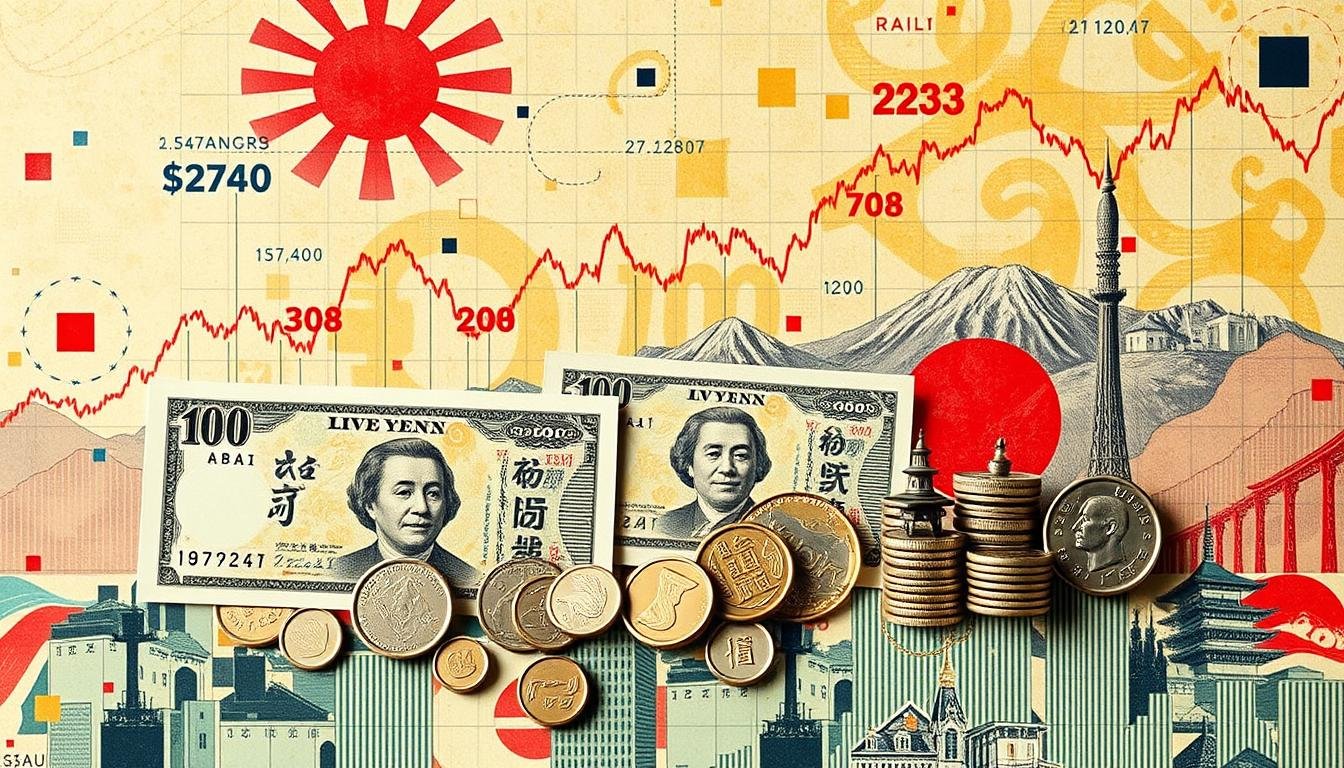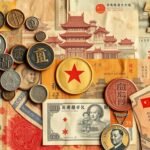
Exploring Japanese currency reveals the yen as Japan’s official currency, established in 1871. It was initially pegged at 1.5 g of gold or 24.26 g of silver1. The yen was split into 100 sen and 1,000 rin1. Grasping the history of Japanese currency exchange rates is key to understanding Japan’s economic past and the factors affecting exchange rates. The yen has seen significant transformations, making it a vital subject for those interested in Japanese currency and exchange rates.
The history of Japanese currency exchange rates is both complex and captivating. It delves into economic history, exchange rates, and the yen itself. By July 2024, the yen’s average rate was ¥158 per dollar and ¥171 per euro1. The yen’s value has fluctuated, depreciating against the dollar by about 60% from late 2020 to mid-20241. Today, the exchange rate stands at 0.0062, with a 0.471% change from yesterday2.
Key Takeaways
- The Japanese yen is the official currency of Japan, introduced in 1871.
- The yen was initially divided into 100 sen and 1,000 rin1.
- Understanding Japanese currency exchange rates is essential for grasping Japan’s economic history.
- The yen has seen significant changes, influenced by events like the Plaza Accord and the Bank of Japan’s monetary policy1.
- The current exchange rate is 0.0062, with a 0.471% change from yesterday2.
- The average exchange rate for the last six months is ¥1 = $0.0066 USD2.
Understanding Japanese Currency Exchange Rate History
The Japanese yen is a key player in global markets, with its exchange rate history being vital for international trade and finance. The yen’s value has seen significant fluctuations over the years. These changes are influenced by economic policies, trade balances, and global events3. To grasp the yen’s exchange rate history, it’s essential to understand the definition of exchange rates and the historical context of the yen’s introduction.
The exchange rate is the price of one currency in terms of another, playing a critical role in global markets. The yen’s exchange rate history is complex and dynamic, influenced by various factors. These include interest rates, inflation, and government policies4. The yen’s value has also been impacted by its performance against other currencies, such as the euro and the pound5.
Here is a brief overview of the yen’s exchange rate history:
- The yen was introduced as a common decimal currency in Japan in 18713.
- The fixed exchange rate of 360 yen per 1 USD was established after World War II3.
- The yen was allowed to float in 1971, and its value has fluctuated ever after3.
The yen’s exchange rate history is both fascinating and critical for those involved in global markets. By analyzing its exchange rate history, we can understand the factors influencing its value. This knowledge is essential for making informed decisions about investments and trade3.
| Year | Exchange Rate (JPY/USD) |
|---|---|
| 1971 | 360 |
| 1980 | 227 |
| 1995 | 80 |
The Birth of Modern Japanese Currency: Meiji Era to Post-WWII
The Meiji era was a transformative period in Japan’s economic history, introducing the yen as the nation’s modern currency6. This era saw the end of traditional coinage and paper currencies, ushering in a standardized system. The Meiji era’s influence on Japanese currency was immense, setting the stage for Japan’s post-WWII economic landscape6.
The yen was initially pegged at 1.5 grams of gold or 24.26 grams of silver6. Japan officially adopted the gold standard in 1897, fixing the yen’s value at 2 yen per gram of gold6. The currency system evolved further with new coins and banknotes. The era’s economic reforms also established a modern banking system, essential for Japan’s post-WWII economic boom6.
Some key events in the development of modern Japanese currency include:
- The introduction of the yen in 18716
- The adoption of the gold standard in 18976
- The abandonment of the gold standard in 19316
- The pegging of the yen to the US dollar in 19496
The Meiji era’s influence is evident in Japan’s modern currency, with the yen remaining a significant global currency6. The era’s economic reforms also shaped Japan’s post-WWII economy, laying the groundwork for its rapid growth in the 20th century6.
| Year | Event | Impact on Japanese Currency |
|---|---|---|
| 1871 | Introduction of the yen | Replacement of traditional coinage and paper currencies |
| 1897 | Adoption of the gold standard | Pegging of the yen to gold |
| 1931 | Abandonment of the gold standard | Currency devaluation and inflation |
The Post-War Economic Miracle and Exchange Rate Impact
Japan’s post-war economy saw remarkable growth, with the yen fixed at ¥360 per USD under the Bretton Woods system7. This era, known as the post-war economic miracle, propelled Japan’s Gross National Product (GNP) to become the second largest globally, surpassing West Germany7. The American occupation was instrumental in molding Japan’s economy, leading to a pattern of chronic current account surpluses7.
The fixed exchange rate era, lasting until 1971, fueled Japan’s economic boom8. During this time, Japan’s coal and metal sectors grew at an annual rate of 25%8. Industrial production rebounded, reaching 350% of pre-war levels by 19608. The economic miracle was marked by substantial income increases, thanks to Prime Minister Hayato Ikeda’s “Doubling the Income” plan7.
The shift to floating exchange rates in 1971 was a turning point for Japan’s economy9. Despite this, the country’s economy continued to expand, with real growth rates remaining positive until 19739. The period from 1960 is dubbed the ‘decade of the economy,’ highlighting a shift in public focus from politics7. Government policies, including tax deductions and preferential loans, boosted exports significantly9.
The Plaza Accord and Its Revolutionary Impact
The Plaza Accord of 1985 was a landmark event in Japanese currency history, causing a sharp yen appreciation. This had a significant impact on Japan’s economy and trade balances10. The accord led to the yen’s value rising from 240 yen to 200 yen per dollar by 1985’s end. By summer 1986, it further appreciated to 150 yen per dollar11.
The economic impact of the Plaza Accord was profound, with Japan entering a recession in the late 1980s10. It also significantly boosted Japan’s trade surplus. This had a deep impact on the country’s economic policies and international trade12.
Some key statistics highlighting the impact of the Plaza Accord include:
- Yen appreciation: 240 yen to 200 yen to the dollar by the end of 198511
- Yen appreciation: 200 yen to 150 yen to the dollar by summer 198611
- Japan’s trade surplus: increased significantly after the Plaza Accord10
The Plaza Accord’s influence on Japan’s economy and currency exchange rates was profound. Its effects are studied by economists today12. The accord marked a turning point in Japan’s economic history. It led to a period of rapid growth and economic impact that shaped the country’s future10.

Japan’s Bubble Economy of the 1980s
The 1980s in Japan were marked by a remarkable economic boom, characterized by a rapid rise in asset prices and a zenith in yen valuation. The yen’s peak valuation was followed by a significant downturn13. This period saw a notable boom in the early 1980s, followed by a sharp decline in the late 1980s14.
The bubble economy’s causes were complex and varied. Key factors included a surge in investment, an uptick in consumer spending, and a notable increase in asset prices. The bubble economy led to a sharp inflation rise and a significant yen value drop13.
Peak Yen Valuation
The yen’s peak valuation, reaching around 200 yen per dollar in the late 1980s, was a critical aspect of the bubble economy14. This peak had profound economic implications, including a surge in exports and a decline in imports.
Economic Implications
The bubble economy’s effects were profound, leading to a sharp decline in economic growth in the late 1980s13. The bubble economy significantly impacted the global market, causing many countries to see a decline in trade with Japan14.
Global Market Effects
The bubble economy’s global market effects were significant, with many countries experiencing a decline in trade with Japan14. The economic implications were far-reaching, with the global market witnessing a notable decline in economic growth in the late 1980s13.
| Year | Yen Valuation | Economic Growth |
|---|---|---|
| 1985 | 200 yen per dollar | 5% |
| 1988 | 150 yen per dollar | 3% |
| 1990 | 120 yen per dollar | 2% |
The Lost Decades and Currency Fluctuations
Japan’s economy hit a snag from 1991 to 2010, dubbed the “lost decades”15. This era saw the yen’s value swing wildly16. The real growth rate averaged about 1% from 2000 to 201016, showing a sluggish pace.
The lost decades left a lasting mark on Japan’s economy. Nominal GDP plummeted from $5.33 trillion in 1995 to $4.21 trillion in 202316. Real wages dropped by around 11% from their peak16. The inflation rate, boosted by monetary easing, hovered between 0–1.0% in the late 2010s16. The yen hit a 37.5-year low at 161 yen/USD in July 202416, adding to the economic woes.
Some key statistics highlight Japan’s economic struggles during the lost decades include:
- Japan’s GDP growth rate averaged 1.3% in the 1990s, far lower than other G-7 countries15.
- The country’s nominal economy size was roughly half that of Germany a decade prior16.
- Real output per capita in Japan was 14% higher than Australia’s in 1991, but had dropped to 14% below by 201116.
These figures underscore the lost decades‘ profound effect on Japan’s economy. The era, known as Japan’s Lost Score or Lost 20 Years, spanned from 1991 to 201015. It was a period of significant economic hurdles for the nation.
Abenomics and Modern Monetary Policy
Abenomics, launched by Prime Minister Shinzo Abe, aimed to boost Japan’s economy. It combined monetary, fiscal, and structural policies. The three arrows strategy, with aggressive monetary policy and a growth strategy, has reshaped Japan’s economy17. This strategy led to a 2 percent inflation target by the Bank of Japan, expected to be met by 201517.
The yen’s depreciation by 21 percent against the dollar in 2013 was significant. The Nikkei 225 stock market index also saw a 57 percent surge17. Internationally, Abenomics received positive feedback, with many seeing its benefits. Abe Shinzō aimed for a 2% inflation rate, aiming to achieve this within two years18. The monetary base was set to double to ¥270 trillion by the end of 201418.
The three arrows strategy has effectively stimulated Japan’s economy. Abenomics increased Japan’s output growth in 2013 by 0.9 to 1.8 percentage points17. The fiscal stimulus in 2013 was 1 percent of GDP17. The consumption tax rose from 5 to 8 percent in April 201417. The IMF forecasts a decrease in the cyclically adjusted primary budget deficit from 8.5 percent of GDP in 2013 to 4.8 percent in 201517.
Major Factors Influencing Japanese Exchange Rates
Several key factors influence the value of the Japanese yen, including exchange rate factors, interest rates, and trade balance. Understanding these elements is vital for predicting the yen’s future value. The yen’s exchange rate is shaped by various economic indicators, like interest rate differentials. These can draw foreign capital, boosting the exchange rate19. A country’s trade balance also plays a significant role, as a deficit can lower the exchange rate19.
A strong currency can make exports less affordable in foreign markets, negatively affecting trade balances19. In contrast, a weaker currency increases import costs and reduces export prices, potentially improving trade balances19. Japan, with its third-largest economy globally in terms of Gross Domestic Product (GDP)20, has seen significant exchange rate fluctuations. The yen hit around 75 per US Dollar in 2011 following the earthquake20. The Plaza Accord also played a role, starting a strengthening trend that nearly reached 80 yen per dollar21.
Understanding the complex interactions between these factors and the yen’s exchange rate requires a historical and statistical perspective. For example, the yen traded between 200 and 270 per dollar in the early 1980s before the Plaza Accord21. By analyzing these elements, individuals can gain insights into the Japanese economy and make informed decisions21.
The Yen as a Safe-Haven Currency
The Japanese yen is often viewed as a safe-haven currency, drawing investors when economic uncertainty looms22. This allure stems from Japan’s economic stability, minimal inflation, and substantial foreign exchange reserves. The yen’s reputation as a safe haven is evident in its performance during crises, like the 2008 global financial crisis. During this time, it strengthened against the US dollar23.
Several factors contribute to the yen’s status as a safe haven:
- Japan’s current account surplus boosts the yen’s appeal as a safe-haven investment24
- The Bank of Japan’s ultra-low interest rates make the yen an attractive, low-yielding safe-haven investment23
- The yen’s historical link to carry trades, fueled by low interest rates24
The yen’s role as a safe-haven currency has profound implications for Japan’s economy and its global financial ties. As a safe-haven, the yen tends to appreciate during economic downturns. This can make Japanese exports more costly and less competitive globally22. Yet, the yen’s safe-haven status also draws foreign investment, aiding in stabilizing Japan’s economy during crises.
| Currency | Safe-Haven Status | Reasons |
|---|---|---|
| Japanese Yen | Yes | Low inflation, large foreign exchange reserves, and economic stability23 |
| Swiss Franc | Yes | Strong banking system, political neutrality, and economic stability24 |
Digital Age Impacts on Japanese Currency Trading
The digital age has profoundly altered Japanese currency trading, with cryptocurrencies and electronic trading platforms leading the charge25. This transformation has quickened the pace and broadened access to currency trading, influencing the yen’s value and Japan’s financial landscape. Investors and policymakers must now adapt to these shifts to stay competitive.
Cryptocurrency influence has emerged as a key player in Japanese currency trading26. The evolution of electronic trading has reshaped market dynamics, drawing more investors to online platforms for currency transactions. The yen’s value has plummeted, reaching levels not seen in 1990, with 160 yen to 1 US dollar25.
Cryptocurrency Influence
Cryptocurrencies have gained traction in Japan, attracting many as an alternative to traditional currencies27. Their rise has fueled electronic trading, with more investors leveraging online platforms for currency transactions. This shift has altered market dynamics, with investors seeking to profit from cryptocurrency volatility.
Electronic Trading Evolution
The evolution of electronic trading has significantly altered currency trading dynamics26. Online platforms have streamlined currency transactions, boosting trading speed and accessibility. This evolution has also spurred cryptocurrency adoption, as investors seek to leverage market volatility.

In conclusion, the digital age has profoundly impacted Japanese currency trading, with cryptocurrencies and electronic trading platforms at the forefront25. As the digital age continues to evolve, we can expect further transformations in currency trading. More investors will likely turn to online platforms and cryptocurrencies to capitalize on market volatility.
| Currency | Value |
|---|---|
| Japanese Yen | 160 yen to 1 US dollar25 |
| Euro | 1 euro to 130 yen26 |
| Australian Dollar | 1 Australian dollar to 90 yen27 |
Current Challenges and Future Outlook
Understanding the current challenges facing Japan’s economy is vital. These include an aging population and trade tensions, which will greatly affect the yen’s future outlook28. The economic trends in Japan are shaped by various elements, such as interest rate differentials and trade balance29.
The Japanese yen has seen significant ups and downs, with the USD/JPY exchange rate hitting highs not seen in over thirty years29. To navigate these economic trends, staying informed about the latest developments and forecasts is essential. For instance, the projected USD/JPY range for 2025 is ¥173–¥17930.
When assessing the future outlook of Japan’s economy, several factors are worth noting:
- Average wage rise in Japan, confirmed at 5.1% in April 202428
- CPI in Japan, expected to reach between 2.5% and 3.0% in 202428
- Bank of Japan’s interest rate decisions, which could influence the yen’s value29
By grasping these current challenges and keeping abreast of the latest economic trends, you can better navigate the complex world of Japanese currency exchange rates. This knowledge is key to making informed decisions about your investments30.
Conclusion
The history of31 Japanese currency exchange rates is a testament to the nation’s economic evolution and its significant influence on global finance. This detailed analysis has delved into the complex factors that have shaped the yen’s journey. It spans from its inception to the current-day challenges it faces.
The31 depreciation of the yen against the U.S. dollar in 2023 marks a significant milestone. It reached levels unseen in 1986, highlighting the currency’s ongoing relevance in international trade. The31 interest rate disparities between Japan and the U.S., along with the31 low hedge ratios of Japanese institutional investors, have played key roles in the yen’s recent decline.
Despite the32 25% drop in the yen’s value over the last two years, Japan’s32 trade balance and32 current account balance have shown remarkable resilience. This resilience is a testament to Japan’s enduring economic strength. The32 highest level of inflation in 40 years and the32 fluctuating trade dynamics continue to influence the yen’s path. Policymakers face the daunting task of ensuring the currency’s stability and competitiveness amidst these challenges.
Grasping the history and31 factors influencing Japanese currency exchange rates is essential for businesses, investors, and policymakers. By studying the yen’s past and present, one can gain insights into its future implications. This knowledge is vital for understanding both Japan’s economy and the broader global financial landscape.
FAQ
What is the definition of exchange rates?
What is the historical context of the Japanese yen?
Why is the Japanese yen important in global markets?
How did the Meiji era impact the development of modern Japanese currency?
How did the post-war economic miracle affect the yen’s exchange rate?
What was the impact of the Plaza Accord on the yen’s value?
How did the Japanese bubble economy of the 1980s impact the yen’s valuation?
What factors contributed to the “lost decades” in Japan and the fluctuations in the yen’s value?
How has Abenomics affected modern monetary policy in Japan?
What are the major factors influencing Japanese exchange rates?
Why is the yen considered a safe-haven currency?
How has the digital age impacted Japanese currency trading?
What are the current challenges facing Japan’s economy and the yen’s future outlook?
Source Links
- Japanese yen – https://en.wikipedia.org/wiki/Japanese_yen
- Japanese yen to US dollars Exchange Rate History | Currency Converter | Wise – https://wise.com/us/currency-converter/jpy-to-usd-rate/history
- Japanese Yen (JPY) – https://corporatefinanceinstitute.com/resources/foreign-exchange/japanese-yen-jpy/
- Japanese yen to Euros Exchange Rate History | Currency Converter | Wise – https://wise.com/gb/currency-converter/jpy-to-eur-rate/history
- Japanese yen to British pounds sterling Exchange Rate History | Currency Converter | Wise – https://wise.com/gb/currency-converter/jpy-to-gbp-rate/history
- The History of the Yen: Japan’s Economic Journey Through Currency – https://scandinavianmarkets.com/2024/08/13/the-history-of-the-yen/
- C:\ANN_JUDD\MISC968-3.KH – http://www.econ.yale.edu/growth_pdf/cdp764.pdf
- Japanese economic miracle – https://en.wikipedia.org/wiki/Japanese_economic_miracle
- The Japanese Economic Miracle – https://econreview.studentorg.berkeley.edu/the-japanese-economic-miracle/
- Japan Forfeits 30 Years to the Gyrations of the Yen – https://www.nippon.com/en/column/g00350/
- PDF – https://conference.nber.org/confer/2023/EASE23/Kuroda.pdf
- Microsoft Word – WorkingPaper-Plaza-Truman-091815.docx – https://www.bakerinstitute.org/sites/default/files/2015-09/import/WorkingPaper-Plaza-Truman-091815.pdf
- Microsoft Word – paper.doc – https://eml.berkeley.edu/~obstfeld/paper_march09.pdf
- Plaza Accord: Definition, History, Purpose, and Its Replacement – https://www.investopedia.com/terms/p/plaza-accord.asp
- Lost Decade in Japan: History and Causes – https://www.investopedia.com/terms/l/lost-decade.asp
- Lost Decades – https://en.wikipedia.org/wiki/Lost_Decades
- PDF – https://www.brookings.edu/wp-content/uploads/2016/07/2014a_Hausman.pdf
- Abenomics: 100 days after taking power – https://grjapan.com/insights/articles/abenomics-100-days-after-taking-power
- 5 Factors That Influence Exchange Rates – https://www.investopedia.com/trading/factors-influence-exchange-rates/
- Major Currency Profile: What to Know About Japanese Yen – Blocs — Framer UI Kit – https://bound.co/blog/know-about-japanese-yen
- The Impact of Exchange Rates on Japan’s Economy – https://www.investopedia.com/articles/investing/051515/impact-exchange-rates-japans-economy.asp
- 9DASHLINE — The Japanese yen in a turbulent global economy – https://www.9dashline.com/article/the-japanese-yen-in-a-turbulent-global-economy
- Exploring the Japanese yen – a ‘safe haven’ currency? – https://www.hl.co.uk/news/exploring-the-japanese-yen-a-safe-haven-currency
- Why Are JPY and CHF considered CHF Safe Haven Currencies? – https://financialsource.co/why-are-jpy-and-chf-considered-safe-haven-currencies/
- Why has the yen fallen to a decade’s low and what does it mean for Japan’s economy? – https://www.theguardian.com/world/2024/apr/30/japan-economy-yen-currency-value-falling-low-impact
- Japan’s falling yen and fiscal space – https://www.brookings.edu/articles/japans-falling-yen-and-fiscal-space/
- Japanese currency and stock market—What happened during the COVID-19 pandemic? – https://pmc.ncbi.nlm.nih.gov/articles/PMC7521471/
- Analytical Dollar to JPY Forecasts in 2024-2025 and Beyond – https://fxopen.com/blog/en/analytical-usd-to-jpy-predictions-in-2024-2025-and-beyond/
- The plight of the Japanese Yen – https://www.fxstreet.com/analysis/the-plight-of-the-japanese-yen-202405090926
- USDJPY Price Forecast & Predictions for 2025, 2026, 2027–2030, 2040 and Beyond | LiteFinance – https://www.litefinance.org/blog/analysts-opinions/usd-jpy-price-prediction/
- Yen to dollar at its weakest level since 1986 – https://www.dws.com/en-hk/insights/cio-view/charts-of-the-week/cotw-2024/chart-of-the-week-20240712/
- Yen Exchange Rate Fluctuations and Japan’s International Investment Position – https://www.rieti.go.jp/en/papers/contribution/ito-hiroyuki/05.html







Interesting read, but isnt it strange how the post-WWII economic miracle didnt significantly impact the Japanese currency exchange rate? Could it be due to external economic factors?
External factors? Ever considered Japans tight monetary policies and high savings rate?
Interesting read, but wouldnt the Yens value fluctuation impact Japans trade deficit more significantly than stated here? Just a thought.
Interesting read! However, I wonder if the rapid industrial growth post-WWII impacted the value of the yen in a more significant way than the exchange rate policies? Any thoughts?
Interesting read, but does anyone else think the Yens strength during the post-war economic miracle mightve been impacted by external factors, like the Marshall Plan?
Interesting read! But isnt it peculiar how the Yens value spiked during the post-war economic miracle? What caused that?